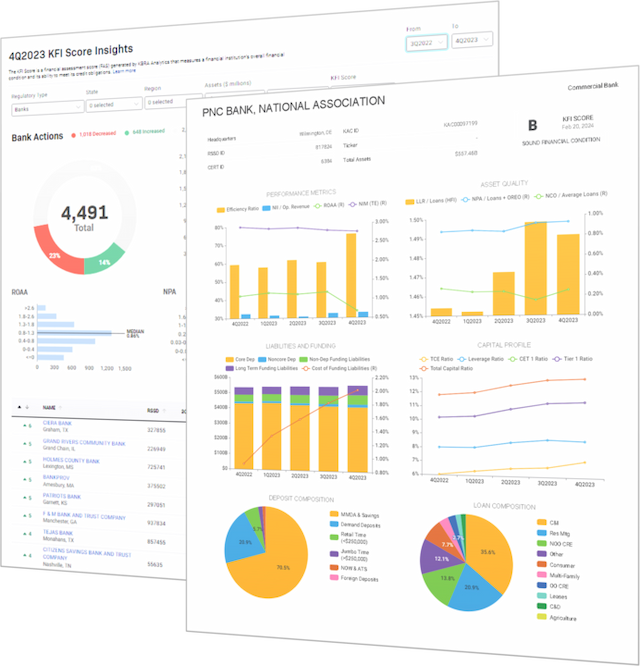KBRA Financial Intelligence
First Bank Failure of 2024
By KFI Staff
Republic First Bancorp. was taken over by regulators on Friday, marking the first billion-dollar bank failure since three major lenders collapsed last year. The bank most recently had KFI Score of C+.
Virtually all the bank’s assets have been taken over by Fulton Bank (KFI Score: B) of Lancaster, Pennsylvania, according to a Federal Deposit Insurance Corporation (FDIC) press release. Fulton, which had about $27 billion in assets, picks up about $6 billion and 32 branches.
The FDIC estimates that the failure will cost its insurance fund about $667 million.
The failure of Republic First echoes what befell its much larger regional peers last year. The lender was sitting on paper losses from low-yielding bonds that lost value as interest rates increased and about one-half of its deposits were uninsured.
The bank had been struggling for years with its tangible common equity ratio declining since 2018, according to call report data compiled by KBRA Financial Intelligence (KFI). Nasdaq delisted the bank’s shares in August for failing to file its annual report. In February, a financing package put together by an investor group fell through, according to a regulatory filing.
Shares have been near zero since they were delisted. The bank’s Market Volatility Score (MVS), which measures a bank’s stock volatility relative to its peers based partly on stock price, deposits, and market capitalization, has been above 90 since August, according to KFI. The MVS measures public lenders from 0 (stable) to 100 (volatile) for real-time comparative peer tracking.
Interested in learning more about KFI’s Market Volatility Score? Please contact: [email protected]
Van’s View on Big Bank Earnings
The biggest banks reported modest stress in their loan portfolios in 1Q, with three of the four largest lenders releasing reserves needed to cover bad loans, according to KBRA’s Chief Strategist Van Hesser.
J.P. Morgan, Bank of America, and Wells Fargo all reported a net release in their loan loss reserves, while Citigroup reported a modest increase in its rainy day fund. Van notes the metric is a more forward-looking indicator than actual loan losses, showing that the biggest lenders are comfortable with current default expectations, even with consumer loan losses normalizing and write-downs of distressed office properties.
Recent stronger-than-expected economic data has pushed out the first expected rate cut from the Federal Reserve to September, according to the CME FedWatch Tool. In December, interest rate traders anticipated the central bank would begin cutting in March.
Fed Chair Jerome Powell said on April 16 that taming inflation “is likely to take longer than expected,” although the central bank is still signaling three 0.25 percentage point rate cuts this year. Van notes that the cumulative effects of monetary tightening will eventually dampen consumer spending, enabling the Fed to bring inflation to target.
For more macro insights, subscribe to Van Hesser’s 3 Things in Credit podcast and his new show, Leading Voices in Credit, which showcases interviews with credit market thought leaders.
Small Utah Lender, Facing Forced Sale, Finds Buyer
A small community bank in Utah, which was advised to either liquidate or sell itself by regulators, has been acquired.
Liberty Bank (KFI Score: E), a Salt Lake City lender with about $12 million in assets, has been taken over by a larger in-state lender, Cache Valley Bank (KFI Score: B), which has almost $3 billion in assets, according to a regulatory posting.
Liberty Bank was instructed to merge or liquidate in an FDIC order in November. The one-branch bank had been unprofitable for years and had run into numerous regulatory issues since the global financial crisis. A KFI Score of E signifies that the lender is likely to have financial problems and poor financial ratios.
Aggregate CRE Exposure May Be a Poor Measure of Risk: Fed
Investors should examine specific types of commercial real estate (CRE) risks such as property type and location instead of just focusing on high levels of exposure, according to a April 18 report from the Kansas City Fed. Small and regional lenders hold large concentrations of CRE loans but smaller properties tend to have much lower expected default rates. The largest office properties—those with more than 500,000 sf—expected defaults are nearly 25% in a sample of 4Q loans, according to the Fed.
More than one-half of overdue CRE loans are held by banks with at least $100 billion in assets, according to a KFI report.
1Q Call Reports Available on KFI Within 24 Hours of Filing More than 5,000 banks and credit unions have filed their 1Q call reports as of April 29. The quarterly reports are added to KBRA Financial Intelligence (KFI) generally within 24 hours after being filed. Use the Data Wizard to see whether your peers have filed.
In Case You Missed It Follow KFI’s new blog for our latest research, data analytics, and product upgrades. Read our insights impacting almost 10,000 banks and credit unions. Some of our recent analysis includes:
Recent M&A
Equity Bancshares Inc. (KFI Score: B+), the $5 billion asset lender in Wichita, Kansas, agreed on April 22 to buy KansasLand Bank (KFI Score: C-), a $55 million asset bank. Since 2002, Equity Bank has completed 23 combined whole-bank, deposit, or branch acquisitions.
Skyline National Bank (KFI Score: B), the $1 billion asset lender in Independence, Virginia, agreed on April 17 to buy Johnson County Bank (KFI: Score A-) for $25 million in an all-cash transaction. The deal, which is expected to be completed in 2H 2024, will create a $1.2 billion asset lender with 28 locations.
Wintrust Financial Corp. (KFI Score: B-), the $56 billion asset lender in Rosemont, Illinois, agreed on April 15 to buy Michigan-based Macatawa Bank (KFI Score: B+) and its holding company for about $510 million, which is one of the larger deals in an otherwise slow mergers and acquisitions (M&A) market. Wintrust will add $2.7 billion in assets from the transaction, which is expected to close in 2H 2024.
